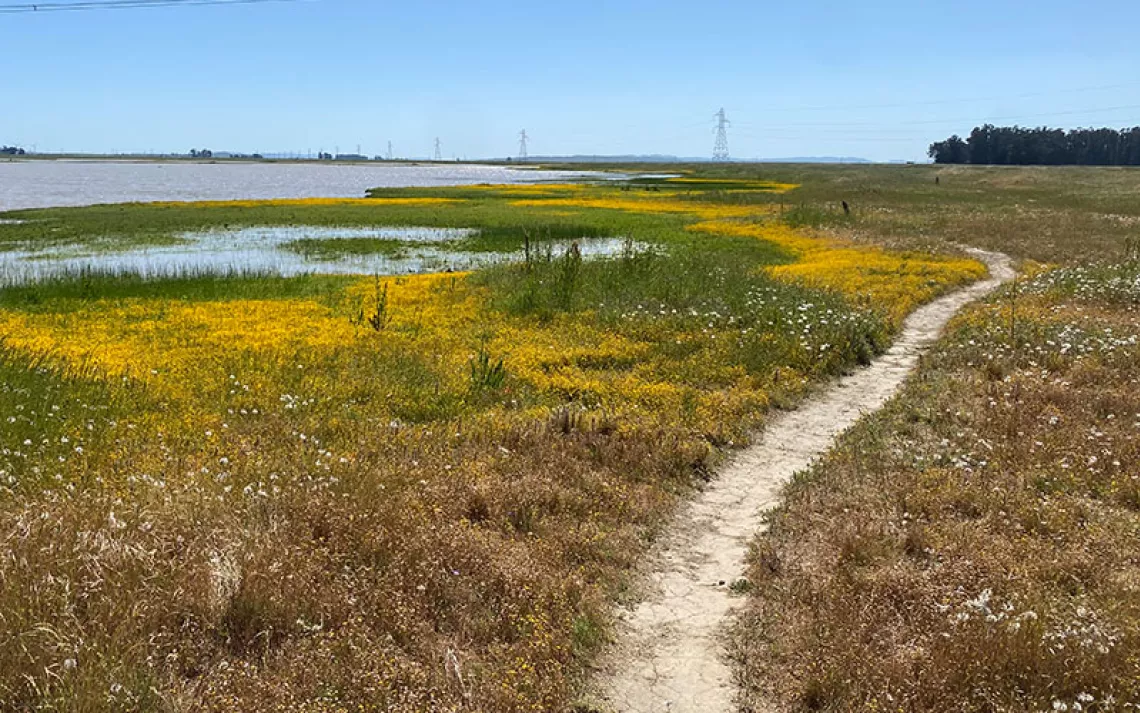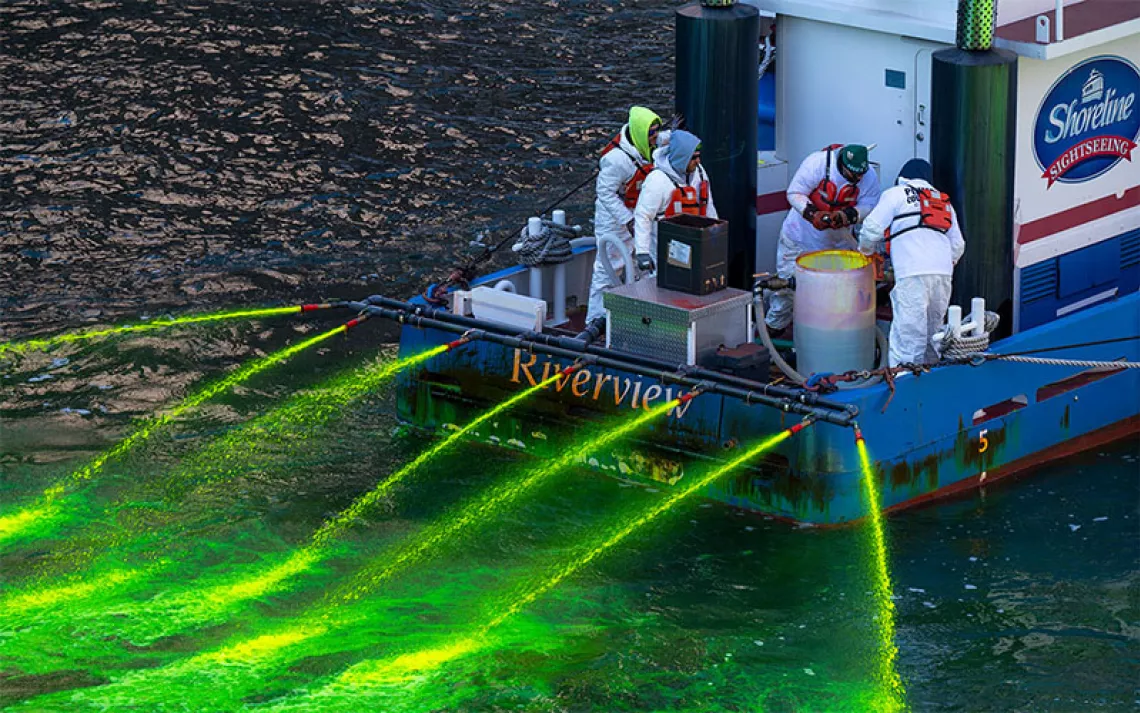Who’s the Green City for, Really?
What NYC’s Little Island says about parks and inequality
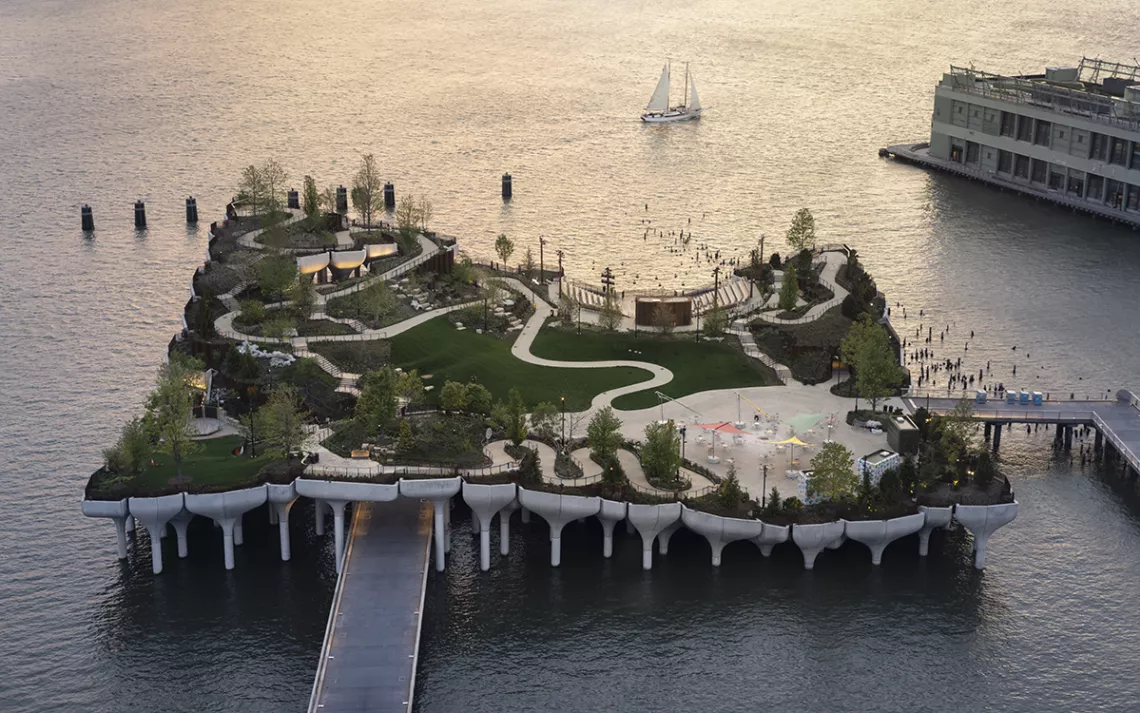
The Little Island as seen from above. | Photo courtesy of Michael Grimm
The Little Island, one of Manhattan’s newest public parks, officially opened in spring. It sits on the edge of Chelsea’s Pier 51—a small patch of green floating above the Hudson River on a forest of mushroom-like concrete pilings.
Chelsea is a formerly working-class neighborhood that is now one of the wealthiest in Manhattan. Chelsea is home to one of the widest income divides, and the Little Island embodies that tension. It’s meant to be a public good (access is free, as are many events held in the auditorium), but much of the money to build it came from Barry Diller, a media mogul who donated $260 million to the project—the largest donation to a public park in NYC history. Diller expects to spend up to $380 million over the next 20 years on upkeep and programming, while New York City and New York State will, collectively, spend up to $21 million just on maintenance.
Heatherwick Studio, the London-based design firm behind the Little Island, has made a name for itself designing fantastical, parklike projects that are described as “biophilic.” Biophilia is an expansive term that was popularized by biologist E.O. Wilson in the early 1980s as shorthand for the idea that humans are innately drawn to and require a connection with nature to live healthy, fulfilling lives. It was redefined as an architectural framework during collaborations between Wilson and Stephen Keller, who taught social ecology at the Yale School of Forestry.
While traditional parks, gardens, and really any form of urban green space are considered biophilic, architecturally, biophilic infrastructure tends to have a distinct, utopic aesthetic: vertical forests (skyscrapers with forests planted in the balconies), living walls (interior or exterior building walls swallowed by plants), and biomimetic design (think the Eastgate Centre in Zimbabwe, designed to emulate termite mounds). The goal is to bring wild ecosystems into dense metropolitan areas. “We don’t just want to go to the park,” says Tim Beatley, the founder of the Biophilic Cities Network (BCN), an international network of over 25 cities committed to integrating nature into the urban landscape. “We want to define the entire city as a park.”
The theory of biophilia is grounded in real science. Studies show that greater access to nature reduces stress, lowers levels of anxiety, and increases cognitive function. Researchers also found that Chicago public housing residents who lived in buildings closer to trees and grass experienced a reduction in aggressive behavior influenced by noise, crowding, and safety concerns. Adding greenery to urban spaces offers a myriad of environmental benefits. Urban tree canopy and green roofs improve air quality, reduce the urban heat island effect, and lower carbon emissions; rain gardens manage stormwater; bird feeders, butterfly gardens, and the addition of native species and wildflowers enhance urban biodiversity. “Nature is not optional,” says Beatley. “It's absolutely essential for leading a healthy, happy, meaningful life.”
What biophilic theory and design is still coming to terms with, though, is that public green spaces have also brought a considerable amount of stress and anxiety to the communities they’re built in, in ways that are less easy to isolate in a science experiment.
“Physical access [to green space] is not enough,” Beatley admits. “If you’re a person of color and have a park within 10 minutes of walking, it doesn’t mean that you’re going to feel comfortable going, or that you’re going to feel welcome or safe.”
A not-so-public public park
The Little Island is not the first high-concept park in Chelsea, or even the most famous. For decades, residents tried to keep an old elevated railroad track in the neighborhood from being torn down, and asked that it be turned into a public space instead. With substantial financial support from wealthy Manhattanites, the rail line was saved and turned into a park—but the result was a showpiece of landscape design that brought in luxury hotels and apartments, and only accelerated the neighborhood’s stratification.
For that reason, some New Yorkers are suspicious of the motives behind the Little Island. In response to the initial proposal to turn Pier 51 into a park, Andrew Berman, the executive director of the Greenwich Village Society for Historic Preservation, told The New York Times that “it does seem a little curious that there’s this vast pool of largely private—but also public (city and state)—money for this addition to the park.” Philanthropists, he added, don’t usually disclose their motivation for funding these projects (in an NBC interview, Barry Diller emphasized that the main motivation for the park was “to make people happy”).
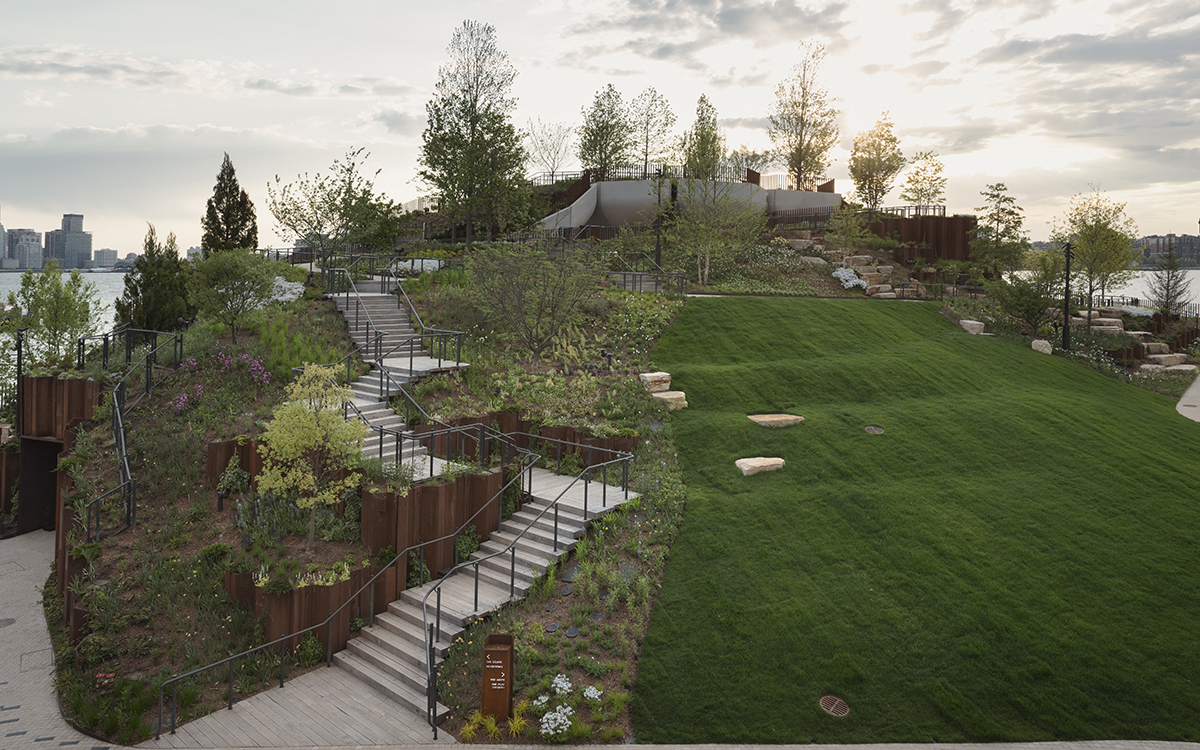
Green = good
“There is this naturalized set of beliefs about nature as a moral, affective good that's universally beneficial and helps humans across class, race, and ethnicity the same way,” says Hillary Angelo, an urban and environmental sociologist at the University of California, Santa Cruz. “It’s a culturally specific way of seeing and understanding nature that we're all trained into in the West.” In her book How Green Became Good: Urbanized Nature and the Making of Cities and Citizens, Angelo writes about how green projects are attractive to developers and politicians precisely because of the assumption that nature is inherently virtuous.
This idea that all green spaces are an unmitigated social good is nothing new, says Angelo. It's a concept that’s existed since the late 19th century. What is unique now, though, is public awareness of ecological concerns like climate change. Green cities are now the epitome of an ideal, modern urban life, and urban planners seek to integrate highly visible, nature-based projects into cities (Angelo sometimes refers to these as “eco-spectacles”). They often do so, she argues, to manifest an aspirational view of what the “perfect” city should look like, as opposed to thinking what’s best for all of its residents.
Because planning decisions are driven by this aspirational look and feel, Angelo says, its ideal visitors are reflected in its amenities, from how expensive food and drink is to the concerts, performances, and other cultural events present. Access to the Little Island may be free, for example, but daily attendance is limited, and the park will close regularly for private events.
When developers design parks
New York is full of plenty of other examples of what public green space can look like. Flushing Meadows Corona Park, where Latino families barbecue on the lawn and Muslims pray near the lake, function as true community hubs.
There are also more cost-effective ways than large-scale green projects like big parks to incorporate biophilic design into urban life. In low-density, peri-urban areas, gardens, bioswales, and urban wetlands can reduce water runoff, protect local waterways through the filtration of stormwater, and create habitats for fish and wildlife, none of which require excessive maintenance. Innovations in public architecture, such as urban street furniture (bus stops, bike stands, and benches used to create microhabitats for native fauna) and technology like Green City Solutions’ CityTree, a block of bioengineered moss and plants that trap air pollutants equivalent to 275 urban trees at 5 percent of the cost, also promise the benefits of biophilia at an affordable rate.
The high-end aesthetic of many new green spaces in urban areas is partly driven by private investors, who have a strong incentive to attract well-to-do visitors to the areas that they help develop. Waterfront development projects are often funded by private capital. The Brooklyn Bridge Park—an 85-acre waterfront project in New York City with rolling hills and lush gardens—is funded by fees from commercial and residential developments; Maryland’s National Harbor—a 540-acre mixed-use waterfront with open water swimming and bike trails—is owned by MGM Resorts International. “For the people who are producing these projects, the public good is not their mandate in quite the same way that it is for a city government,” Angelo says. “You end up with various kinds of compromises made to make these spaces profitable.”
“Someone's going to build wealth every time we change the built environment," says Barbara Wilson, an environmental planning professor at the University of Virginia. “It is just very rare that the people who benefit are those who already live in a low-income community.” If a new green space attracts wealthier residents and real estate speculators looking for cheap property to redevelop, the most marginalized people in the neighborhood may be forced to leave. As a result, they’re left with a longer commute to the city center and higher carbon footprints.
The hierarchies of city government can also privilege developers and other insiders over local residents. City planning decisions are often top-down, explains Anna Muessig, an urban planner and associate at Gehl, an urban research and design consulting firm. Urban planners report to their managers, who report to their bosses and follow the chain of command all the way up to city officials with executive decision-making power (for example, a mayor or a city commissioner).
The promise of community collaboration
The experts I spoke to all agreed that there’s still potential for even ambitious new green spaces to be equitable. "Ultimately, so much of this comes down to political will,” says Anna Muessig. “Politicians are influenced by community power.” “People know what they need,” says Barbara Wilson. “We just never know better than people that live in their own neighborhoods.”
When green spaces are developed from the bottom up, rather than the top down, the results are very different. In Cully—a low-income, predominantly Latino neighborhood in Portland, Oregon—residents worked with Portland’s parks department and Verde, a local nonprofit, to turn a 25-acre landfill into Thomas Cully Park, which contains walking paths, sports fields, a playground, and a tribal gathering area.
As property values began to rise, residents and local community organizations used strategies outlined in the Living Cully Community Energy Plan. They persuaded the city to loan funds to help purchase a mobile home park in order to cap rent prices and organized residents to resist rent increases.
In Washington, DC, the 11th Street Bridge Park was built following the Equitable Development Plan, a $56 million effort led by the district government and community organization Building Bridges Across the River. The goal in developing the park was to connect the wealthy communities west of the Anacostia River with low-income, majority Black communities to the east of the river without displacing the people currently living on the low-income side. To that end, the Douglass Community Land Trust secured over 300 units of affordable housing in Ward 8, while the Economic Development Plan also led to homeownership information sessions, Know Your Rights tenant trainings, job training programs, and social services.
Nonetheless, urban planners with the intention of building green neighborhoods with equity front-and-center must forge their plans beyond the addition of a few extra trees, parks, and open space. “What would help the most with social equity and ecological concerns are investments in things like public transit and affordable housing,” Angelo says.
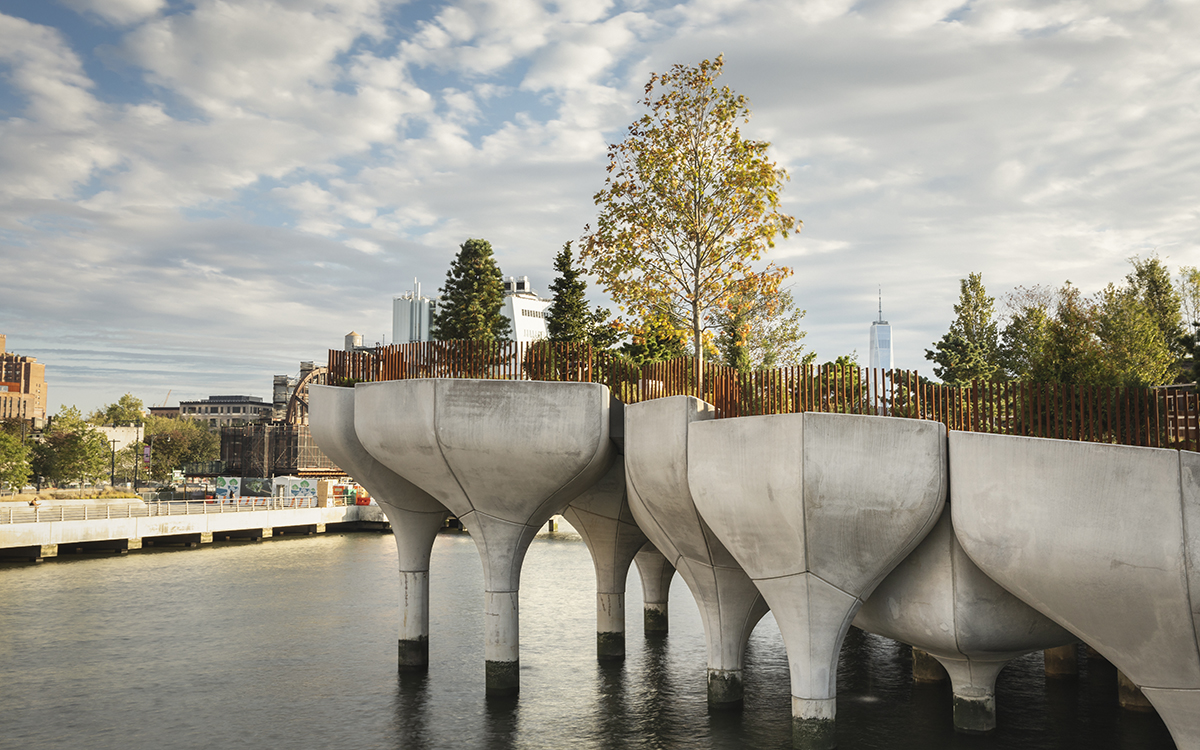
A very manicured park
The first time I saw the Little Island in person was on a humid morning in June. From across the wooden bridge connecting the park, it looked like a flying saucer that clumsily landed on the Hudson River. Inside the park, food trucks were selling avocado toast for $10.
To my left was a sloped, fenced-off yellowing lawn (a park staffer told me it was going through maintenance). To my right were a series of winding paths clambering up a hill. The trails were encased by a curated selection of plants—35 different trees, 65 types of shrubs, and roughly 300 varieties of grasses and perennials. In front of me was an undulating landscape of beautifully manicured greenery, juxtaposed against the New Jersey skyline.
I made my way up one of the paths, pausing every few seconds to make way for nannies pushing strollers and tourists taking selfies. A few minutes later, the trail abruptly ended at an amphitheater. There were waterfront overlooks on either side, but seeing how crowded they were, I continued walking, past uniformed park employees and security cameras nestled in the greenery.
Just as quickly, I found myself abruptly at the park exit, descending back to ground level. Did I miss something? After a few more sweltering, disorienting rounds, I caught my breath at a table shaded by an umbrella, where two strangers joined me and my friend. I asked them what they thought of the park. “Such a cute little concept,” said one woman. The other said it reminded her of an amusement park. They walked away to buy cocktails.
 The Magazine of The Sierra Club
The Magazine of The Sierra Club


